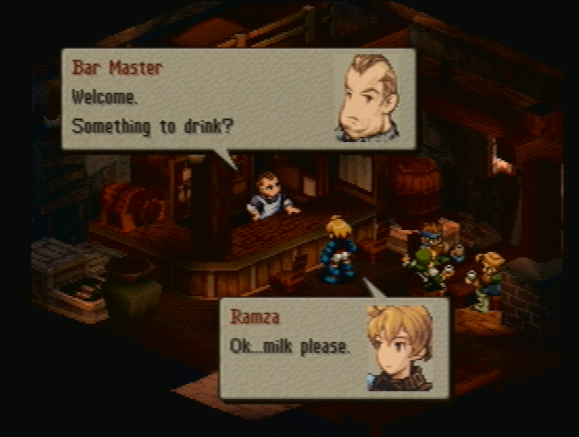One of the most glaring omissions on my backlog progress is Final Fantasy Tactics, one of those games that on paper should be a sure thing. And I’ve made a pass at it in the past. Quite a while ago I was going to play FFT for the Fangamer Game Club, a community playthrough, but circumstances att he time delayed my start and I just couldn’t gel with a tactics game while under a truncated deadline at that time. And as it happens, when you put down an RPG sometimes you become reticent to comes back. And that mistake is on me.
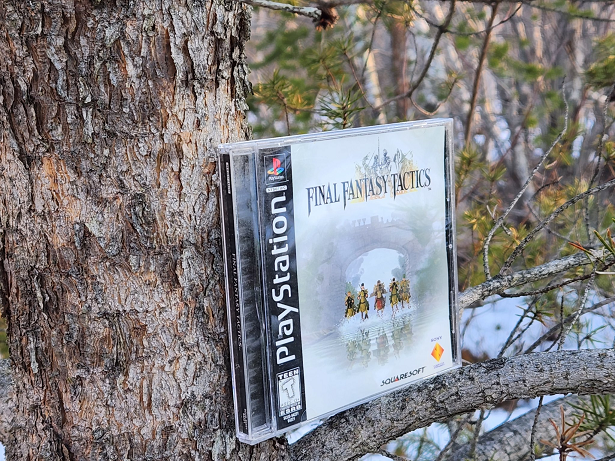
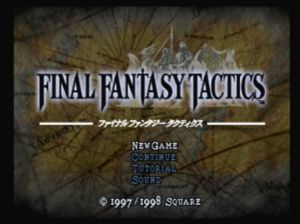
Tactics Ogre Reborn was released recently, in 2022. I spent a few months playing that game and grinding in the postgame and the more I played the more I wanted to revisit the other Ogre games I love but also Final Fantasy Tactics – a game I previously dropped. Final Fantasy Tactics (FFT) has influence and talent from Tactics Ogre, and the footprint of the Ogre series is apparent but not overbearing.
Final Fantasy Tactics is a turn based tactical RPG factoring in unit class and ability configuration, terrain height and obstruction, and a focus on a sobering narrative. Your party size is generally limited to five or less characters, plus any guests, and a lot of importance is placed upon an individual unit. The class system is a take on the Job systems found in titles like FF3 and FF5 many of which are classic Final Fantasy roles. You will gain Job levels and Job Points which can be spent on Abilities endemic to those jobs. Even items must be unlocked through the Chemist class, with the ability to use each item locked behind a JP cost and item itself being an ability that must be slotted on other classes.
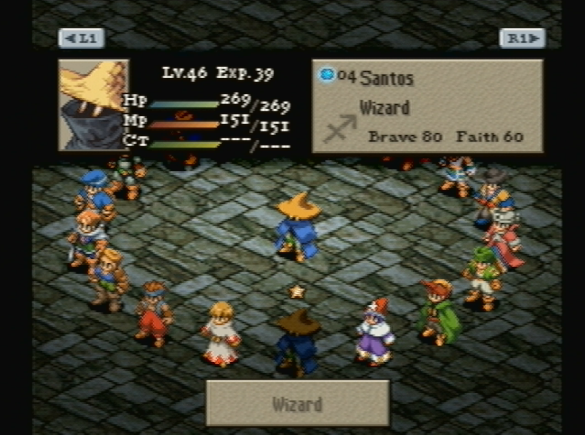
This can sound very limiting but the game allows for a solid amount of customization. You will have the base ability of your current Job, the ability to slot another action – such as Item or Jump, a reaction – such as Counter or Auto Potion, an intrinsic buff – like the Ninja’s ability to equip two weapons or the Monk’s unarmed strikes, and a movement ability – such as boosting your movement distance or restoring a portion of MP after moving. There are some very potent combinations, such as combining the Ninja’s intrinsic on a Monk (or the other way around) for two very potent unarmed strikes. I usually only had Item on one or two characters depending on what I wanted to accomplish because there are other options for healing and raising built into other kits. And while the game will punish missteps, it really does feel like many combinations can make due and that you should experiment.
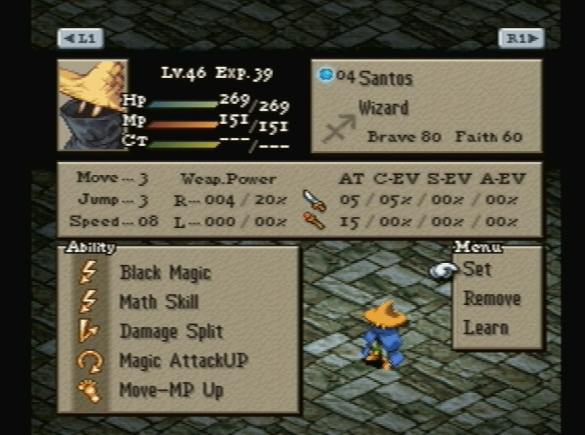
The game offers a decent selection of named characters to recruit with unique base classes, especially towards the end of the game. I found myself reluctant to start training a new unit that late in however since the tradeoff to the level of customization is the amount of time investment each individual character requires. Some of the units you can recruit come very potent out of the gate but generally outside of Ramza I stuck with three of my generic units from the start of the game and Agrias since she was there for a large chunk of the game. Reda, Demi, and Santos – my Lancer (Dragoon), Summoner, and Wizard (Black Mage) I grew to like and kept their core Jobs because I like those roles in other Final Fantasy games.
So I found the game very accomodating. Tactics has a reputation of being either difficult or easy and it does have the potential to be any level of those. Familiarity with the genre obviously plays a large role since there’s certain gameplay expectations when it comes to controlling the inertia of battle. And with the extra importance we give individual units and their roles, having one get knocked out because you moved too far in could swing the momentum of battle very quickly. Even building towards Abilities can be overwhelming on your first playthrough when you don’t know how good they are but it costs 900JP which is no small investment early in the game. There are ways to grind JP of course, which will overlevel you, but your HP and MP largely come from armour available at the time and if you haven’t spent your JP on cohesive abilities and if you get careless then the opponents can still get the better of you.
The Calculator is a take on the Blue Magic Level?Spell mechanics – hitting targets that coincide with a division formula – with more parameters. The Calculator themself has fairly low speed and less magic attack than the Wizard. But once you gain some parameters for Math Skills you can add that Ability to a faster and more potent Job to and then they can hit any unit on – friend or foe – that matches their chosen formula with most of the spells they’ve learned in other Jobs without casting time or cost or range considerations. There’s a character that joins late in the game that is almost hilariously strong and has a workable skillset right out of the gate. So, there are ways to take the teeth out of encounters in this game either through what is outright given to you or what you invest time in. But you also don’t have to chose these options. I generally didn’t use the Math Skill outside of random encounters, and I kept Agrias over the character introduced later (and she is pretty strong herself). I got along fine with my Lancer once I focused on getting the most out of Jump even though I’m sure she could have done more in another Job with or without taking Jump with her.
One element that took me by surprise in Tactics was the the enemy’s ability to Steal and Sunder equipment. Stealing is RPGs is usually limited to consumables or money but in FFT a Thief can steal your armour off your body or a Knight can break your weapon and so on. Of course you too can steal and break enemy equipment, and the Chemist has an ability to prevent your gear from being sundered or stolen. There’s ways of playing around this. One of the times I did wipe out in this game was a random encounter against a party of Ninjas. Every Ninja in this forest was throwing weapons at me as they closed in quickly whittling down my casters since they had superior speed to most of my units. If I had the Catch ability equipped then my units could have caught those weapons and added them to my inventory. But I wouldn’t have had Catch equipped unless I knew I was going to fight enemies with Throw, and this is apparently a rare encounter that I couldn’t have planned for until I knew it was possible. But once you know, you know. You can either take the time to change your Abilities before you risk passing that location on the world map again, or circumvent it, or just use your previous experience to maneuver better if it pops up again.
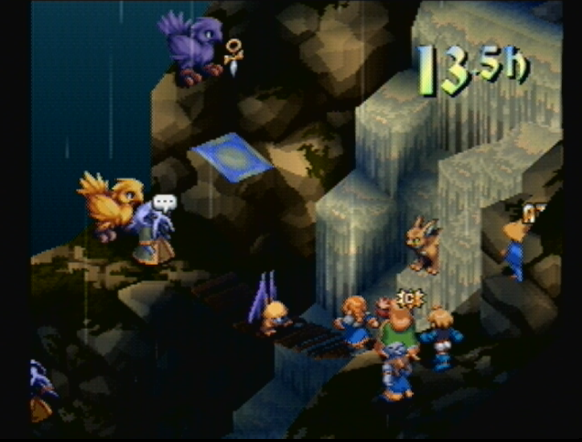
Most of the challenge in FFT comes from the learning process and once you have an understanding of mechanics and locations then things come together much more smoothly. That might sound like stating the obvious – and it is – but for instance you will not find some of the best items in this game unless you use the Chemist’s movement ability to find items when you step on designated tiles. These tiles can have a common and rare find and can be in some hard to reach spots. So unless you’ve got a chart, or you comb every map you will probably miss some good stuff. But I didn’t interact with this system and I got by just fine. I wouldn’t look at it like being punished for not exploring, but more that you’re rewarded for it. We used to say elements like that made “guide selling games” and yeah, if you’re overly concerned about missables you may feel that way.
As you play you will understand what functionality you need to make your unit click, or certain systems like how Faith effects your magic potency, susceptibility, and accuracy. There are systems I didn’t really interact with myself, like Zodiac compatibility. Very few obstacles can’t be overcome with a bit of planning the few exceptions maybe being some of the multi map encounters where if you’re not keeping multiple saves you could lock yourself into a dire situation. But keep staggered saves, play around with the systems, and you can get as much out of FFT as you put into it.
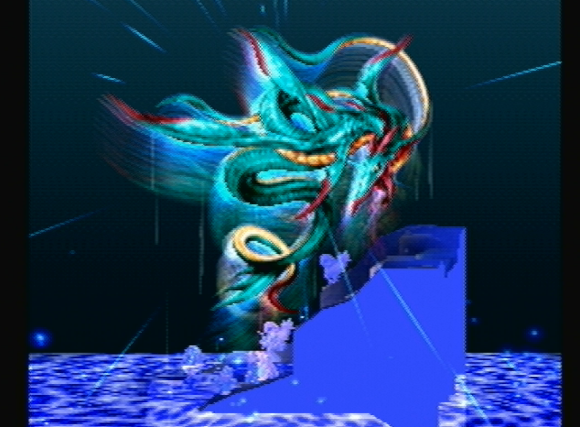
And I really have laboured the point because I feel like there’s a lot to get out of Final Fantasy Tactics. This is a more sobering story about the contrasting paths of two friends, Ramza and Delita. Delita is a commoner and Ramza is a noble and their ambitions and morality dictate major events in the world while the turmoil of the War of the Lions provides a backdrop.
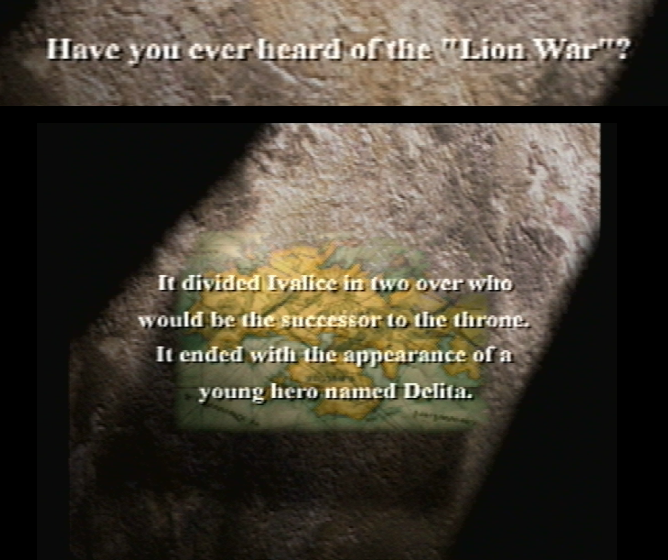
I don’t generally criticize old translations and scripts, but there definitely feels like there was something lost in translation with FFT. The story is there, especially if you take the time to check the Rumors at each new city Bar you come to. But with the typos and sentence structure sometimes being spotty in a game that leans so heavily on character and narrative it could be tightened up. One of the reasons I haven’t played and grinded FFT to start maxing out multiple jobs is that I would like to play the War of the Lions version or whatever remake is inevitable in the wake of Tactics Ogre Reborn.
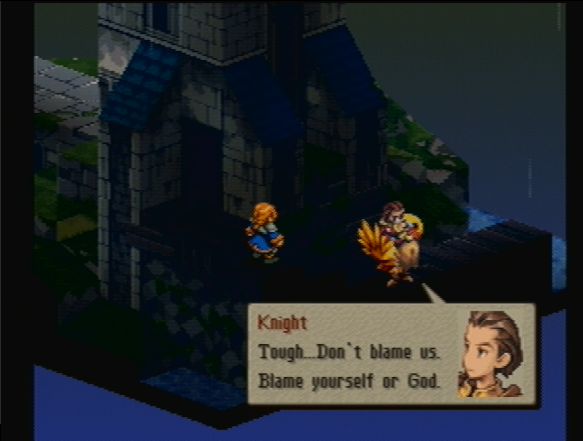
I don’t know which script is better, and to be fair FFT’s narrative and characterization break through the spottiness. When early in the game a character’s sprite shoots Ramza a spiteful look after being reprimanded you get a more complete picture of that character and their attitude towards you. The soundtrack and visuals offer a lot of contextualization for events and characters throughout the game, you’re not just beholden to the text.
Ramza was born into nobility, the youngest brother of the Beoulve family. His notion of social castes and the world is tested early in the game, there are voices who want him to stay in his line and those that want him to deviate. It’s not an unusual setup but it’s done earnestly here and it worked for me since I did start to really like Ramza. He’s a just but naive kid who wants to do the right thing and wants his family to do the right thing. But it’s not just righteous indignation, it’s his unerring belief in his want to help others. While Ramza has some potent combat skills in his base class and can learn all of the Jobs available to most other characters his real strength is in his conviction.
Ramza has incredible conviction but he still has moments of naivety and setbacks along his quest, but he grows across the course of the game and becomes more and more embroiled in the real conflict at the heart of the War of the Lions. He still wants to believe in fair exchanges or in the intentions of his friends even when the world doesn’t want to accomodate an ideology like that. He’s just a likeable character and while I wonder what the game would have been like with critical cascading choice like Tactics Ogre’s Order and Chaos paths this is his story and he stays true to his character and I think that works for Final Fantasy Tactics.
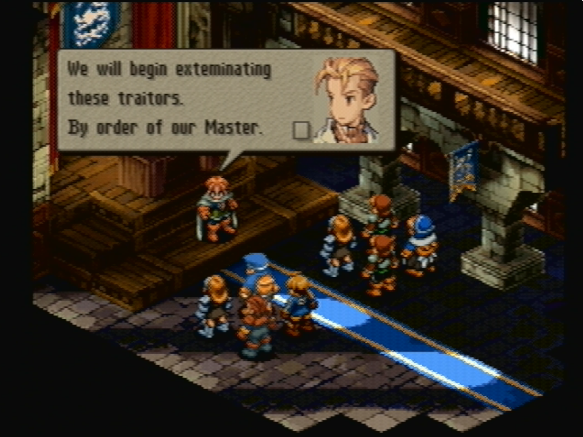
FFT is a story of upending the status quo and it is a story of conviction and sacrifice. It’s a story of friendship, and it’s a coming of age. It’s a darker, more somber Final Fantasy narrative set during a war for Ivalice. There’s world lore that comes to be reflected in the plot, such as the Zodiac Brave Story. It’s a rich world with compelling hooks. Ivalice is an enduring setting because it has a strong backbone to carry it.
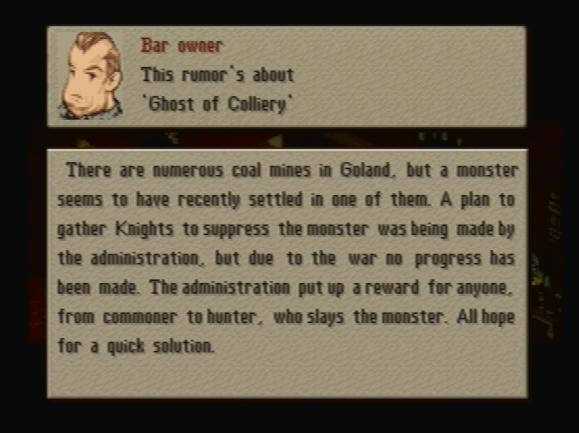
Final Fantasy Tactics’ aesthetic endures as well. The character sprites don’t clash with the 3D environment, they mesh well. Maps are varies and some are quite interesting like the city Goulg. Moreover, Jobs are usually evocative of how they were presented in past titles and a good portion of the bestiary are Final Fantasy mainstays. The soundtrack is beautiful and contextual, the first time I heard the Hero’s Theme I was struck by it. Or the track The Pervert and the entire scenario unfolding at that moment. While the tone of FFT was different than many games in the series it still feels like Final Fantasy. It still works today because it’s just as endearing as it ever was, and good art direction and composition endure.
I was concerned picking up Final Fantasy Tactics so soon after a Tactics Ogre playthrough. I thought comparisons were going to be inevitable – and you can’t help but make them considering a lot of the shared themes and design choices. But Final Fantasy Tactics feels like its own thing, different enough that I was quick to just start enjoying the game loop and getting invested in Ramza’s story instead of just lamenting that the Ogre Battle Saga is still incomplete. FFT lends itself to quicker battles by virtue of the party size, compact maps, and the killing potential of you or the enemy. It gives it a different feeling than a longer, more protracted loop and makes it feel like Final Fantasy with a Tactics bent. Mainline FF usually had parties of 3-5 and with a handful of opponents after all. Whether that’ to your preferences or counter to them, it does help FFT to maintain its own identity and its mechanics allow it to work within those tenants.
Final Fantasy Tactics still has a lot to offer today. It’s generous enough that you will get by if you’re new to the genre, but has lots of avenues for powergaming as well. There’s still things for me to do or experience. I haven’t interacted with the fur shops, barely touched the propositions, didn’t worry about move-find, or max out more than a few of the Jobs, or fully optimize my team. I didn’t even look into recruiting monsters since the party roster is only 16 slots and I didn’t interact much with hidden characters found near the endgame. Part of this is because I’m coming off playing Tactics Ogre Reborn exhaustively earlier in the year, the other part is that I want to leave room for a second helping of Final Fantasy Tactics.

War of the Lions looks like it boosts the available character slots a little, as well as featuring extra content. I don’t know when I will get to that, or if I will wait and see if the often rumoured remake or remaster is in the cards. But I’m coming off of this game with a very high opinion and I will dive in again.
Returning to Final Fantasy Tactics to give it a real go, I knew that it would be mechanically solid since I have touched upon it briefly in the past. I wasn’t expecting to get as invested in the characters and the overarching plot as I was, to really look forward to getting back to it each night. Definitely worth the playthrough.
